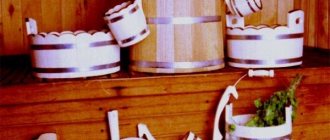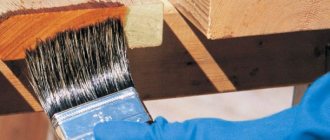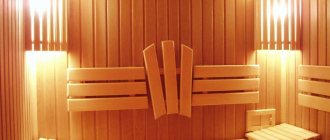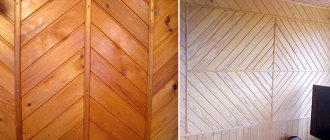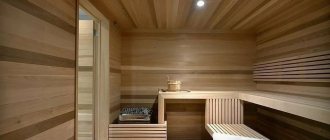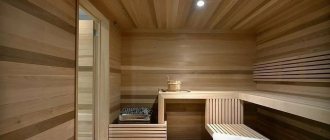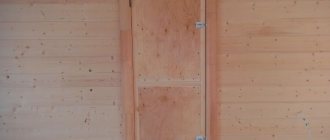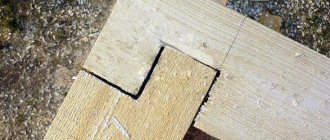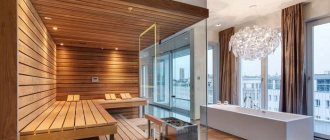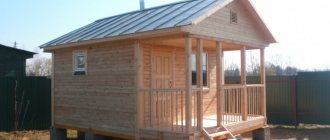Mold on boards is a common occurrence, which, however, requires radical measures. It won’t be difficult to remove mold just once: it can be easily cleaned off. However, it is already difficult to achieve lasting protection against reappearance.
There are many products for treating boards against fungus, but it is best not to use any specific product, but to combine several. It is necessary to treat lumber with different means at intervals: today one means, after a few days another.
Reasons for appearance
Mold is a fungus that reproduces by attaching and propagating spores. Individual boards or the entire bathhouse become a site of fungal attack only when favorable conditions occur. These include:
- high humidity;
- elevated temperature;
- insufficient air circulation in the room.
In order to choose the optimal control method, first determine the cause of the formations. Methods include both measuring temperature and humidity using special instruments.
How does it affect wooden surfaces?
Microscopic fungi lead to the destruction of the place where they live. Boards and any wooden furniture are destroyed, and there is no way to hide this afterwards.
You will only have to buy new things, which, of course, is not profitable, since without getting rid of the cause of the fungus in the house, it will also quickly become unusable.
But besides this, it should be understood that fungi are not entirely localized on the surface. They literally fly around the room, which can cause not only allergic reactions in people and animals there, but also, as doctors say, cancer.
Kinds
The type of mold determines the choice of method that will help you effectively deal with it forever.
Black
Black mold is the most active and fastest growing of all. It usually destroys the surface quickly. There are several strains that cannot be distinguished from each other without special research.
It is very dangerous for humans, as if it enters the body it causes poisoning and allergies. Fighting black mold is quite difficult - it is not susceptible to most folk and chemical preparations.
Xin
Blue is not so dangerous for the human body, but it causes destruction of structures. Affects fresh and old wood, leading to its rotting. Particularly dangerous for load-bearing structures.
Putrefactive fungus
Putrefactive fungus spreads under conditions of high humidity in the room and the presence of external sources of moisture. Antiseptics and home methods can cope with it.
See also
How to remove an air conditioner from a wall with your own hands during repairs
White
White mold affects not only furniture, but also food. It is easy to deal with, since it is not resistant to aggressive drugs. It does not pose any significant danger to the body.
Preventive wood treatment
Reducing the humidity level (less than 70%) and high-quality ventilation will help protect internal surfaces. Impregnating or coating external structures with antifungal products is a must for a long-lasting structure. Folk or ready-made remedies can be used. So, Tikkuril primers are applied before painting or varnishing.
The coating is renewed when damage occurs. The affected area is cleaned and additionally treated with an antifungal drug. The entire surface of the façade can be preventively coated with a mold preventative every 3-4 years.
- The material is attacked by various microorganisms that destroy it and harm human health.
- Mold develops due to high humidity, poor ventilation and insufficient maintenance, leading to the formation of cracks in the material, creating favorable conditions for spores.
- Wood is a porous structure; chlorine and ammonia compounds are not suitable for cleaning it. It is better to stick to essential oils, boron and commercial products.
- Folk and ready-made remedies are used for preventive treatment. You also need to monitor the cleanliness (integrity) of the facade and the microclimate in the premises.
Interesting! In the United States alone, these microorganisms cause $73 billion worth of damage to structures annually.
The destruction of structures exposed to infection occurs quickly. It is difficult to get rid of pests due to the deep penetration of spores. It is better to treat materials preventatively and regularly inspect structures to remove pathogens in the early stages of development.
First steps when colonies are detected
You need to think about how to get rid of mold immediately after it is discovered. Delay will lead to the fact that it will be almost impossible to cope with the fungus; it will destroy the furniture. The first steps include the following steps:
- creating optimal humidity and temperature;
- providing ventilation;
- eliminating fungus using a knife with a sharp blade or a metal brush;
- burning of purified fungus;
- washing with a detergent solution;
- antiseptic treatment for furniture.
But it should be noted that such actions do not always lead to a positive result. They are only a temporary salvation, since if the mold is firmly ingrained into the surface, then it cannot be dealt with this way.
Rules for storing silver products
For cutlery, buy boxes with compartments lined with soft fabric. Jewelry is stored in a special box. Items should not be piled up; friction will cause scratches on them. In addition, the chain gets tangled and can be broken. It is permissible to put jewelry in separate plastic bags and store it in a common box.
Choose a place for decorations with normal humidity, away from heating devices and direct sunlight.
Basic rules for caring for silver jewelry
Knowing how to clean a silver chain, cutlery, or jewelry with stones, you won’t have any problems removing plaque. But it is easier to prevent discoloration than to fight it. A few recommendations will help maintain the beauty of your accessories:
- jewelry is removed before visiting a bathhouse, sauna, or taking a bath;
- promptly clean products from dust and dirt;
- before using creams and masks, remove the rings;
- wear protective gloves when doing household work - rings and bracelets can easily be scratched with a knife or brush.
Silver accessories do not cause any special trouble. Regular cleaning from darkening, polishing items with oil or preventive treatment with lipstick will help preserve the beauty of brooches, rings and earrings for a very long time.
Basic cleaning methods
You can use these methods.
Solutions
Solutions are effective at the initial and middle stages. They contain active chemical components that remove the source of infection and serve as additional disinfection.
"Dali"
You can remove blue, putrefactive fungus and white mold using the Dali solution. It shows a high degree of efficiency, but has a low price. Be sure to wear protective equipment before use, as contact with solution molecules can lead to allergies.
"Biotol-spray"
Biotol-spray will help remove fungus at any stage. Its advantage is its rather pleasant smell and ease of application. You will need to clean off the fungus and simply spray it on the surface and wait for it to be absorbed.
"Alpa"
"Alpa" is a popular chemical with a strong composition. It is applied to the surface for a few minutes and then wiped off. The components can cause the surface to fade, so you need to be careful.
"Stop-Mold"
Russian chemical agent with a wide range of actions. Suitable for removing any type of fungus, does not cause allergies.
Traditional methods
Traditional methods of fighting fungus do exist, and they cope just as effectively as solutions.
Chlorine bleaches
Chlorine is an effective substance that removes mold. Therefore, among traditional methods of combating mold, chlorine-containing bleaches occupy a leading position. The liquid lightens the wood, which is worth considering when working with a dark surface. First, the boards are cleaned and filled with “White” for several hours. Wash off with a large volume of warm water, areas are covered with tea tree oil.
Pharmacy antiseptics
Antiseptics for mold control are sold over the counter in pharmacies. Their price is minimal, making them a smart choice in most cases.
Water soluble
Water-soluble ones are diluted with water, and then the surface is washed with them. Sold in the form of dry powders. The advantage is that the surface treated with them is safe for humans and animals living in the house, but is destructive for all types of parasites.
Deep penetration water repellent
Suitable for situations where the formation of fungus is caused by conditions of high humidity. It has a strong smell, so you need to wear a mask and ensure good ventilation when working.
See also
TOP 7 products that can be used to lubricate the front door lock and processing rules
Oily
With their help, wood products are processed at the initial stage of production. The oil forms a protective film on the surface of which spores cannot exist.
Solvent based
These options are designed to combat severely affected areas. They have an aggressive composition, so you should work taking into account all protection standards.
Combined
Combined ones also cope with other types of parasites. The instructions specify what composition they have, and the permissible doses for a particular case.
Vinegar and soda
The area of spread is sprinkled with a thick layer of soda, then sprinkled with acetic acid. Cleans up after 2 hours with a dry cloth.
Resin
Resin is a safe, effective and inexpensive method to eliminate mold. It is heated before use and applied to the cleaned area with a paint brush. The surface may remain sticky, so they additionally treat it with tea tree - it removes stickiness and also gives a pleasant smell.
Silicate glue
Silicate glue is diluted with warm water to a viscous liquid state. They cover the surface in two layers and leave.
Potassium bichromate, sulfuric acid
You will need a 5% solution of potassium dichromate and sulfuric acid. The boards are processed, it is safe. You should be careful when working with soil.
Vinegar and soda
The area is covered with soda and vinegar is poured onto it. Wait until the violent reaction ends and sweep away with a brush.
Salt, acid and boiling water
Removal occurs with a solution of 5 liters of water and 50 grams of boric acid. The wood is processed, cleaned with oil and varnished.
Copper sulfate
100 grams of copper sulfate are dissolved in 10 liters of water. The boards are treated completely, even those places that were not affected.
Tea tree oil
Tea tree oil protects against parasites by creating a protective film on the surface. It prevents microbes from multiplying. The wood is treated with oil after the fungus has been eliminated; a soft brush is used for this.
Professional compositions
Professional formulations give a greater effect, as they contain chemical compounds. You should be careful when removing - read the instructions.
"Tikkurila"
"Tikkurila" is a universal product intended for varnishing panel, wooden, brick and other surfaces. The antiseptic, in addition to eliminating bacteria, gives a glossy appearance.
"Senezh"
"Senezh" is a special composition that is used to enhance the protection of wood from rot, mold and insects. This is a strong remedy that must be used in strict accordance with the instructions.
"Belinka"
"Belinka" is an antiseptic composition that has a low cost. Protects against rotting, mold and fungi of various natures.
"Aquatex"
"Aquatex" is a product intended for treating wood against mold. Processing of damp wood is allowed.
"Neomid"
"Neomid" is a universal impregnation product. It is both a bleach and an impregnation that performs protective and decorative functions.
How to choose the right tool and method
The means and method of combating the fungus are selected depending on several parameters. You will need:
- find out what exactly caused the mold to spread;
- determine the type of fungus and strain (sometimes this requires the help of specialized specialists);
- see what kind of wood it is, that is, its moisture level, color, wood markings.
See also
How to fold socks compactly, rules and storage methods
For home use, water-repellent solutions and soluble varnishes against fungus are suitable. Dry rooms - you can choose paint and varnish coatings.
For outdoor work, harsher chemical compounds are used.
But an ordinary person can always determine an effective method of combating fungus. If we are talking about damaged furniture, then as a last resort, you can throw it out and buy a new one. But if the fungus has infected the load-bearing structures of the building, then it is better to leave the work to specialists.
Appeal to professionals
Turning to professionals is an expensive procedure, but it will be 100% effective and will rid your home of the harmful effects of pathogenic microorganisms. This is a whole process that requires preparation. It is carried out according to the algorithm:
- identifying the cause;
- restriction of all furniture and structures from contact with other things;
- ensuring optimal climatic conditions for work;
- complete destruction of mechanical fungus;
- chemical treatment;
- drying and restoration measures, if required;
- coating with antiseptic and varnish.
Of course, the scope of work varies depending on the conditions (outdoors or indoors, the size of the surface being treated), and the type of formation.
How to prevent mold from reoccurring
To prevent mold from settling on the walls of your home again, you should follow certain rules:
- ventilate the room more often;
- do not place furniture close to the wall, leave at least a minimum gap to ensure air passage;
- the drainage system should be organized in such a way that melt and rainwater do not flow down the walls;
- the façade of the house is also hydrophobic;
- use preventive measures;
- leave a small distance between the wall and thermal insulation materials.
Please note that if your neighbors’ houses are infected with mold or have noticeable cracks, the problem can quickly spread to you. Warn her by following all the above rules.
Prevention methods
The set of preventive measures will take less time than treating a simple fungus at home. Problems are easier to prevent, so it is important to ensure their ventilation in a bathhouse or wooden house.
Hydro- and vapor barrier
The main reason for the formation of pathogenic microorganisms is excessive humidity levels and the influence of steam. It is important to protect furniture and structures from this. Therefore, it is imperative to use special varnishes that protect the wood.
In a room where the humidity is always exceeded due to objective factors, for example, in a bathhouse, it is necessary to ensure a pleasant microclimate and regular ventilation.
Roof and foundation integrity
Before putting the house into operation, the roof and foundation must be covered with paints, varnishes and antiseptics. The appearance of fungus in these structures is not always noticeable, but as a result they grow and cause harm. Cleaning and application occur only on a clean surface; brushes, sprayers and rollers are used.
Vapor barrier membrane for protection against condensation
A vapor barrier membrane will protect against condensation and serve as an additional measure. The event is presented as a whole.
A little about mold
Mold in a wooden house is the simplest microorganisms that very quickly unite into numerous colonies, which quickly become visible to the human eye.
If there are several types of mold - wood-staining, which destroys wood and causes harm to humans, and wood-destroying - which does not have a negative effect on people, but contributes to the rapid destruction of walls. In case of large lesions, the house is usually designated for demolition.
The most poisonous mold is yellow. It releases substances that, in some cases, lead to the formation of tumors.
